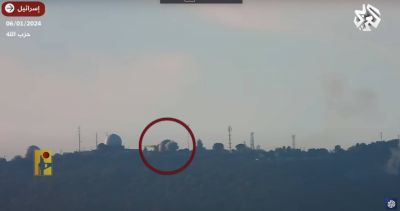
A screeb grab of Al-Arabi news service broadcasting a video by Hezbollah showing its strike against the Meron air surveillance base in northern Israel, Saturday Jan. 6.
On Saturday, Hezbollah says it attacked Israel's Meron air surveillance base with 62 missiles as part of its initial response to the killing of senior Hamas leader Saleh al-Arouri in Beirut's southern suburbs on Tuesday, Jan. 2. The attack was one of the most significant since the start of the conflict between Hezbollah and Israel on Oct. 8, 2023.
L'Orient Today takes a closer look at this attack and its potential significance.
How significant is this attack?
Hezbollah claims that the Meron air base, which is located on the top of Mount Jarmaq, is the only center for surveillance and air control in northern Israel. "It is one of two main bases in Israel: Meron in the north, and the second one is Mitzpe Ramon in the south," the party said.
A video Hezbollah posted about the attack shows what appears to be anti-tank guided missiles fired on the facility and hitting the radars that give Israel an aerial picture of the entire northern theater, deep into Lebanon. It is also said to be a major military base that covers military air traffic for northern Israel, Lebanon, Syria, Cyprus and Turkey.
The Israeli army on Sunday admitted that the strikes caused damage to the facility but that it is still functioning using a backup system. Israeli army spokesperson Daniel Hagari said the damage to the base would be repaired. He added that the army would investigate the incident to avoid similar attacks in future.
"The attack is significant in the sense that the target is an important military base for the Israelis, and I suspect that Hezbollah was saving this target for a special occasion. It is only 7 km south of the border and it is visible from places like Yaroun," Nicholas Blanford, author of Warriors of God: Inside Hezbollah's Thirty-Year Struggle Against Israel told L'Orient Today.
Hezbollah had reportedly targeted the base at the beginning of the current conflict with Israel, after which the Israeli army made some preparations in case of further strikes on the facility, according to a Haaretz report.
Targeting weaknesses in the Israeli military defense
The Israeli army possesses an advanced system called "TROPHY" which is installed on armored vehicles to protect the personnel inside. It can detect and destroy incoming threats before they hit the vehicle. Hezbollah has been using anti-tank missiles since the beginning of the war against static military buildings because they cannot be protected by the "TROPHY" system, Haaretz reports.
The Israeli newspaper poses the question as to why the Israeli army did not put a fence around the sensitive installations, as it has done along the northern border. According to Haaretz these fences could have sustained the impact of the anti-tank missiles, triggering the explosion of their warheads, and preventing most, if not all, the damage to the facilities themselves.
"They probably did not expect it to be attacked by long-range anti-tank missiles which have a range of between eight and 10 km. Normally, if you look at the Israeli position along the Blue Line, you'll see them smothered with anti-missile netting. It is assumed that they didn’t have it around the Meron base, and I would think they probably didn’t think they needed it given its distance with Lebanese territory," Blanford says.
On Saturday, the Israeli air force put the "Sky Dew" system into use, following a year and a half of it being inoperable due to technical malfunction. The system is supposed to provide Israel with long-range, early warnings of aerial threats over its territory. The radar, mounted on an aerostat in the north of the country, is supposed to warn of the launch of cruise missiles and low-altitude drones held by Iranian forces and pro-Iranian militias in Iraq, Syria and Lebanon, Haaretz says.
Asked whether the attack would disrupt air traffic operations in Lebanon, Blanford said, "Israelis I think have backup measures, I don’t know the significance of the damage, but I doubt that it would stop Israel’s air activity in Lebanon and Syria."
